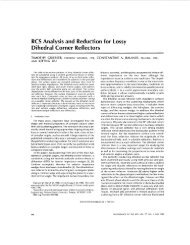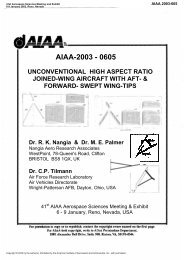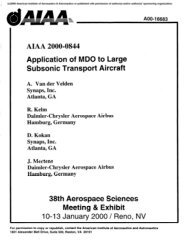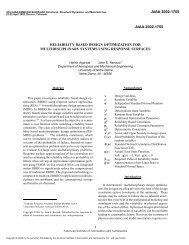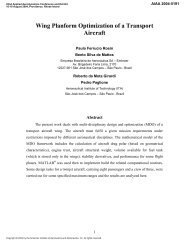The design report
The design report
The design report
Create successful ePaper yourself
Turn your PDF publications into a flip-book with our unique Google optimized e-Paper software.
ibs as well as predetermined screw holes in the fuselage. It was decided that as the<br />
vertical tails were comparatively small relative to the rest of the components, it would<br />
not be compulsory to disconnect them for transport. Hence the vertical tails were glued<br />
and attached to the fuselages prior to the test flight day.<br />
Another adjustment to the <strong>design</strong> of the aircraft essential for the dismantlement was the<br />
necessary discontinuity of the wires within the aircraft. <strong>The</strong> wires between the<br />
fuselages, wing and horizontal tail had to be able to easily connect and disconnect at a<br />
point so as to allow each component to be transported independently. This meant that<br />
on assembly, the wires within the wing had to be pulled down between a hole in the<br />
bottom of the wing and top of fuselage, and then connected with their fuselage<br />
counterparts. Similarly, wires protruding from the fuselage were connected to their<br />
counterparts on the horizontal tail. <strong>The</strong> task of attaching the two fuselages to the wing<br />
and the horizontal tail plane, and connecting all the necessary wires was in theory a<br />
relatively simple task, which had on all previous occasions been performed in less than<br />
ten minutes. However, on the day of the flight tests, various complications arose which<br />
hindered the speed of the assembly.<br />
<strong>The</strong> first such complication occurred as the left fuselage was being attached to the wing.<br />
Each fuselage was attached to the wing using five screws. So as not to lose the nuts<br />
involved in this procedure, these had been screwed onto the screws protruding from<br />
the fuselage while it was separated from the wing. This first problem arose due to the<br />
fact that while trying to find an innovative solution using super glue, the team had<br />
inadvertently glued several nuts and screws together. This led to an excruciating 10<br />
minutes in which the team wrestled to remove the super glued nuts.<br />
After overcoming this initial issue, assembly was continued. However, after both<br />
fuselages had been attached to the wing, it was noticed that one of the wires in the left<br />
fuselage had wrapped itself around a rib in the wing, and was caught between the wing<br />
and the fuselage. This meant that the left fuselage had to be completely removed from<br />
the wing to untangle the wire. This wasted another few minutes, and contributed to the<br />
fact that the assembly took almost twice as long as expected. <strong>The</strong> final task performed<br />
pre-flight was the connection of the electronics, and the subsequent checking of the<br />
control surfaces and motors. This was performed without any glitches.<br />
Measurement of Weight and CG location 5.11<br />
Part Conceptual <strong>design</strong> phase using formulae (kg) CATIA (kg)<br />
0.38311494<br />
After Fabrication<br />
(kg)<br />
Wing 0.42756<br />
2 1.080<br />
Fuselage 0.803238976 0.8372 1.230+1.210=2.44<br />
Horizontal<br />
tail 0.076920509<br />
0.08195874<br />
2 0.215<br />
Vertical Tail 0.10029 0.0572<br />
Landing gear 0.251998638 0.25<br />
Propeller 0.1 0.1<br />
Total Weight 1.959 1.7094 3.73








![Introduction to RF Stealth [Book Review] - Antennas and ...](https://img.yumpu.com/16857890/1/190x245/introduction-to-rf-stealth-book-review-antennas-and-.jpg?quality=85)

